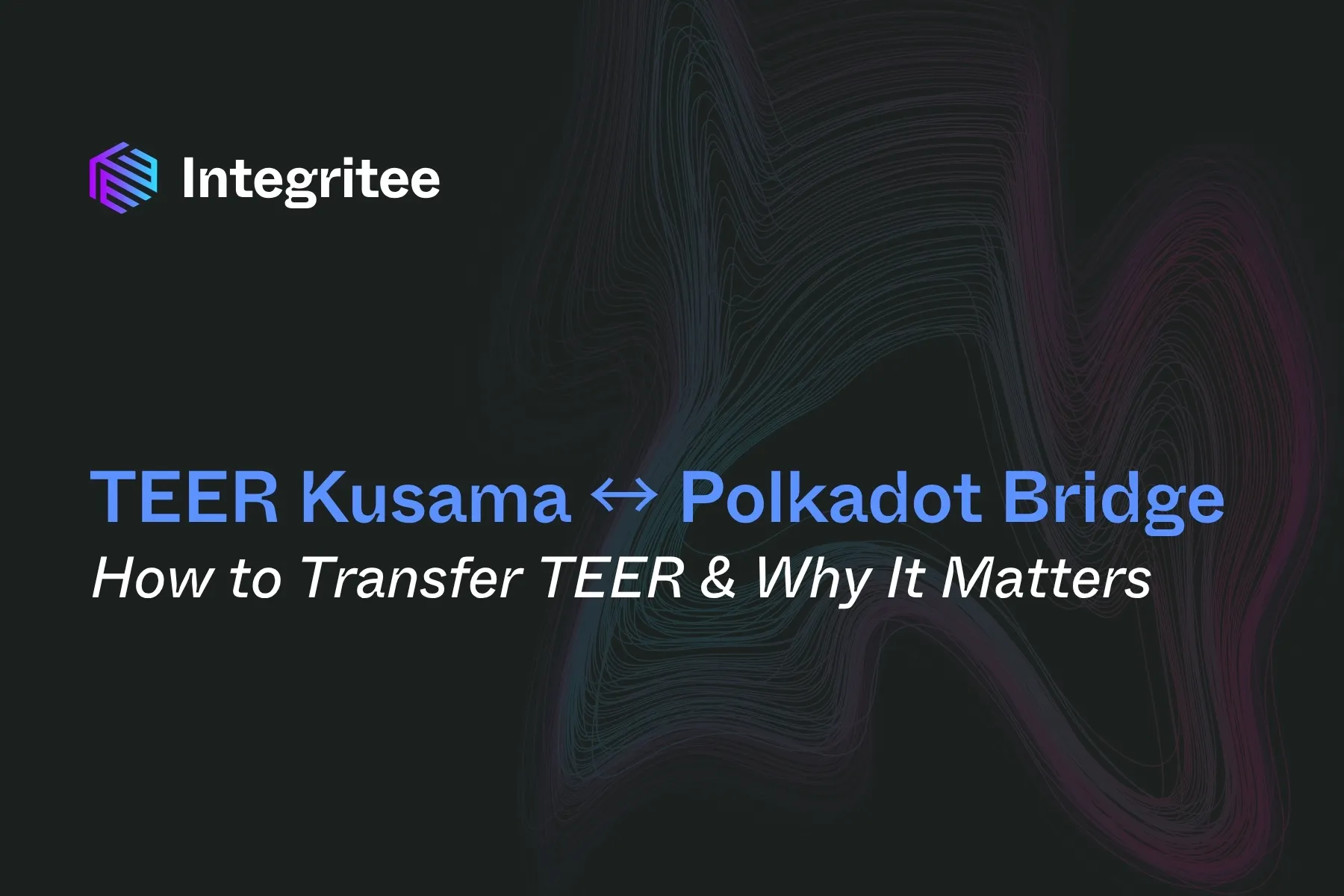We’ve just released our TEER Bridge, a new tool that bridges TEER between Integritee-Kusama and Integritee-Polkadot. Why is this convenient and important? Polkadot hosts many parachains with numerous projects. In this article, we explain how to use the Bridge tool and why it matters.
Bridging is like transferring your tokens from one blockchain to another. Integritee operates a Parachain on multiple chains (Kusama and Polkadot). As of now, your TEER tokens reside only on our Kusama Parachain, where we issued them as crowdloan rewards and where centralized exchanges currently withdraw and deposit from. Being able to transfer them to Polkadot will open up different opportunities and enable transfers from there to other ecosystems. In short, it opens up a whole new world of possibilities.
How to bridge TEER
You’ll use a trustless Bridge. On the source chain where your tokens are, you will burn (destroy) the amount you want to move. Within a few minutes, the equivalent number of tokens is minted on the target chain.
Note that there’s a fee for bridging (paid in TEER, on the chain you’re sending from).
Here’s a step-by-step guide:
- Visit the Bridge app or Open Subwallet’s (desktop extension or mobile app) dApps and type in crosschain.integritee.network.
- The “TEER CrossChain Tool” will open. All you need to do is choose the desired extension, for example subwallet-js or polkadot-js. Choose the account you want to transfer TEER from, and click “connect”.
- Select the account from the dropdown. “From chain” will say “Integritee (Kusama), and “To Chain” will, by default, present “Polkadot AssetHub (GW to Ethereum).
- You’ll see the available transferable balances on both origin and destination networks. In “amount to teleport”, input the amount you wish to bridge.
- Hit the transfer button.
⚠️ Important ⚠️
– By default, the bridge interface is set to transfer TEER to Polkadot AssetHub. This only works if you already have DOT on AssetHub, because you’ll need it to cover fees on that chain. If you don’t have any DOT, the message “Your account on the destination chain is not able to exist by only holding TEER. Please transfer some DOT first” will appear.
To get your TEER back to Integritee Kusama, the route you should follow is: Polkadot AssetHub ➡️ Integritee (Polkadot) ➡️ Integritee (Kusama)
– If you want to use centralized exchanges, do not transfer your TEER from Integritee Kusama to Polkadot for now, as you won’t be able to send them to centralized exchanges from there. Having TEER on Polkadot will be useful to use different dApps and access other ecosystems like Uniswap on Ethereum, but transferring and receiving TEER via centralized exchanges is an operation done in our Kusama parachain for the time being.
Also, check out our full tutorial here.
Types of bridges: trustless vs trusted
Trustless bridges are those that operate without having to “trust” anyone, including third parties that act as intermediaries, or people who validate the transfers. These types of bridges use smart contracts or protocols, making trust in humans or central authorities unnecessary. Polkadot’s Snowbridge, along with Integritee’s new TEER Bridge, are trustless. It’s more about trusting the code than the human.
Snowbridge — which you can use to transfer TEER between Polkadot and Ethereum — works with light clients. Both Ethereum and Polkadot run a light client of each other’s blockchain inside their networks. This means that when you send TEER from Polkadot to Ethereum, Snowbridge checks the transaction directly against Polkadot’s consensus.
Trusted bridges rely on a third party to watch both blockchains and ensure transfers are valid. The first Web3 bridges to be created were trusted. Operators lock tokens on one side and mint new ones on the other. Trust is in the validators, a multisig wallet, or the company running the bridge. Examples of such connections include the Binance Bridge and Wormhole.
Are trustless bridges more secure?
Any Web3 connection has the potential to be hacked; however, they do provide more security. Cointelegraph argues that “the main security benefit of trustless bridges is that users maintain custody of their tokens during the whole process, with smart contracts taking care of the transfer process. Additionally, the lack of a central authority to lock up the tokens makes the bridges harder to attack since there is no single point of failure.”
• • •
About Integritee
Integritee is the most scalable, privacy-enabling network with a Parachain on Kusama and Polkadot. Our SDK solution combines the security and trust of Polkadot, the scalability of second-layer Sidechains, and the confidentiality of Trusted Execution Environments (TEE), special-purpose hardware based on Intel Software Guard Extensions (SGX) technology, inside which computations run securely, confidentially, and verifiably.
Community & Social Media:
Join Integritee on Discord | Telegram | Twitter | Medium | Youtube | LinkedIn | Website
Products:
L2 Sidechains | Trusted Off-chain Workers | Teeracle | Attesteer | Securitee | Incognitee
Integritee Network:
Governance | Explorer | Mainnet | Github
